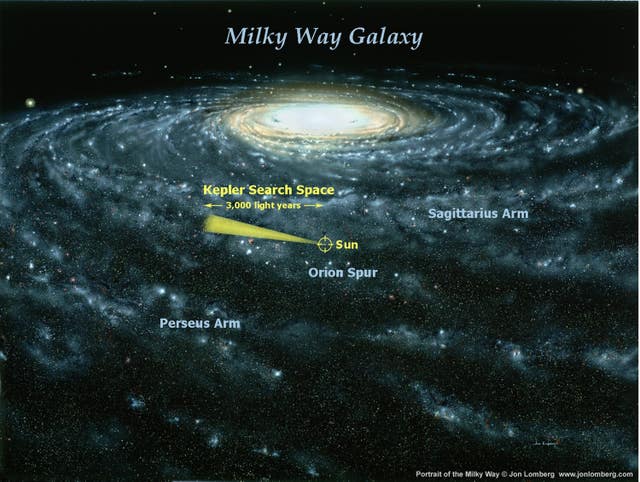
Our galaxy the Milky Way is growing and predicted to expand into its neighbour Andromeda, say scientists.
Thankfully, the cosmic collision will not happen for about another four billion years.
 Artist’s impression of our galaxy, the Milky Way, showing position of the sun. The image was issued by Nasa to highlight a Kepler space telescope operation (Nasa/PA)
Artist’s impression of our galaxy, the Milky Way, showing position of the sun. The image was issued by Nasa to highlight a Kepler space telescope operation (Nasa/PA)
The Milky Way, a barred spiral galaxy, is already huge with a diameter of about 100,000 light years. It is home to several hundred billion stars, including the sun which occupies an insignificant spot within one of its minor spiral arms.
At the outer edge of the main body of the galaxy, the galactic disc, new stars are still being created out of gas and dust. Computer simulations suggest that the new stars will slowly increase the size of the galaxy.
To check if this was right, scientists looked at other galaxies similar to the Milky Way using a number of ground-based and space telescopes.
They calculated that the Milky Way, and other galaxies like it, are growing at around 500 metres per second.
Spanish lead researcher Cristina Martinez-Lombilla, from the Astrophysical Institute of the Canaries in Tenerife, said: “The Milky Way is pretty big already. But our work shows that at least the visible part of it is slowly increasing in size, as stars form on the galactic outskirts.
“It won’t be quick, but if you could travel forward in time and look at the galaxy in three billion years’ time it would be about 5% bigger than today.”
In about four billion years the Milky Way is predicted to collide and merge with its mighty neighbour, the Andromeda galaxy, she said.
Currently a safe 2.5 million light years away, the Andromeda galaxy is even larger than the Milky Way. Also a spiral galaxy, it is 110,000 light years across and contains an estimated one trillion stars.
The new research will be presented on Tuesday April 3, at the European Week of Astronomy and Space Science meeting in Liverpool.


Why are you making commenting on The Herald only available to subscribers?
It should have been a safe space for informed debate, somewhere for readers to discuss issues around the biggest stories of the day, but all too often the below the line comments on most websites have become bogged down by off-topic discussions and abuse.
heraldscotland.com is tackling this problem by allowing only subscribers to comment.
We are doing this to improve the experience for our loyal readers and we believe it will reduce the ability of trolls and troublemakers, who occasionally find their way onto our site, to abuse our journalists and readers. We also hope it will help the comments section fulfil its promise as a part of Scotland's conversation with itself.
We are lucky at The Herald. We are read by an informed, educated readership who can add their knowledge and insights to our stories.
That is invaluable.
We are making the subscriber-only change to support our valued readers, who tell us they don't want the site cluttered up with irrelevant comments, untruths and abuse.
In the past, the journalist’s job was to collect and distribute information to the audience. Technology means that readers can shape a discussion. We look forward to hearing from you on heraldscotland.com
Comments & Moderation
Readers’ comments: You are personally liable for the content of any comments you upload to this website, so please act responsibly. We do not pre-moderate or monitor readers’ comments appearing on our websites, but we do post-moderate in response to complaints we receive or otherwise when a potential problem comes to our attention. You can make a complaint by using the ‘report this post’ link . We may then apply our discretion under the user terms to amend or delete comments.
Post moderation is undertaken full-time 9am-6pm on weekdays, and on a part-time basis outwith those hours.
Read the rules here